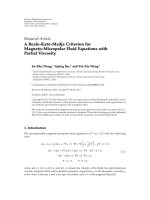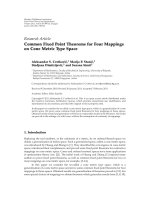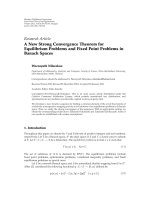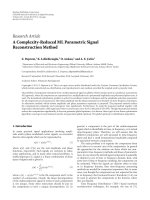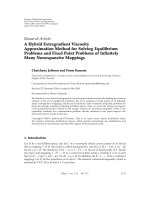Báo cáo hóa học: "Research Article A Fixed Point Approach to the Stability of a Functional Equation of the Spiral of Theodorus" pptx
Bạn đang xem bản rút gọn của tài liệu. Xem và tải ngay bản đầy đủ của tài liệu tại đây (473.77 KB, 7 trang )
Hindawi Publishing Corporation
Fixed Point Theory and Applications
Volume 2008, Article ID 945010, 7 pages
doi:10.1155/2008/945010
Research Article
A Fixed Point Approach to the Stability of
a Functional Equation of the Spiral of Theodorus
Soon-Mo Jung
1
and John Michael Rassias
2
1
Mathematics Section, College of Science and Technology, Hong-Ik University,
339-701 Chochiwon, South Korea
2
Mathematics Section, Pedagogical Department, National and Capodistrian University of Athens,
4 Agamemnonos Street, Aghia Paraskevi, Attikis, 15342 Athens, Greece
Correspondence should be addressed to John Michael Rassias,
Received 2 April 2008; Accepted 26 June 2008
Recommended by Fabio Zanolin
C
˘
adariu and Radu applied the fixed point method to the investigation of Cauchy and Jensen func-
tional equations. In this paper, we adopt the idea of C
˘
adariu and Radu to prove the stability of a
functional equation of the spiral of Theodorus, fx 11 i/
√
x 1 fx.
Copyright q 2008 S M. Jung and J. M. Rassias. This is an open access article distributed under
the Creative Commons Attribution License, which permits unrestricted use, distribution, and
reproduction in any medium, provided the original work is properly cited.
1. Introduction
In 1940, Ulam 1 gave a wide ranging talk before the mathematics club of the University of
Wisconsin in w hich he discussed a number of important unsolved problems. Among those
was the question concerning the stability of group homomorphisms: let G
1
be a group and let G
2
be a metric group with the metric d·, ·.Givenε>0, does there exist a δ>0 such that if a function
h : G
1
→ G
2
satisfies the inequality dhxy,hxhy <δfor all x, y ∈ G
1
, then there exists a
homomorphism H : G
1
→ G
2
with dhx,Hx <εfor all x ∈ G
1
?
The case of approximately additive functions was solved by Hyers 2 under the as-
sumption that G
1
and G
2
are Banach spaces. Indeed, he proved that each solution of the in-
equality fx y − fx − fy≤ε, for all x and y, can be approximated by an exact so-
lution, say an additive function. Later, the result of Hyers was significantly generalized for
additive mappings by Aoki 3see also 4 and for linear mappings by Rassias 5.Itshould
be remarked that we can find in the books 6–8 a lot of references concerning the stability of
functional equations see also 9–11.
Recently, Jung and Sahoo 12 proved the generalized Hyers-Ulam stability of the func-
tional equation f
√
r
2
1frarctan1/r which is closely related to the square root spiral,
for the case that f10andfr is monotone increasing for r>0 see also 13, 14.
2 Fixed Point Theory and Applications
In 2003, C
˘
adariu and Radu 15 applied the fixed point method to the investigation of
Jensen’s functional equation see 16–19. Using such a clever idea, they could present a short
and simple proof for the stability of the Cauchy functional equation.
In 20, Gronau investigated the solutions of the Theodorus functional equation
fx 1
1
i
√
x 1
fx, 1.1
where i
√
−1. The function T : −1, ∞ → C defined by
Tx
∞
k1
1 i/
√
k
1 i/
√
x k
1.2
is called the Theodorus function.
Theorem 1.1. The unique solution f : −1, ∞ → C of 1.1 satisfying the additional condition that
lim
n →∞
fx n
fn
1 1.3
for all x ∈ 0, 1 is the Theodorus function.
Theorem 1.2. If f : −1, ∞ →
C is a solution of 1.1 such that f01, |fx| is monotonic and
argfx is monotonic and continuous, then f is the Theodorus function.
Theorem 1.3. If f : −1, ∞ → C is a solution of 1.1 such that f01, |fx| and argfx are
monotonic and such that argfn 1 argfn arg 1 i/
√
n 1 for any n ∈{0, 1, 2, },
then f is the Theodorus function.
In this paper, we will adopt the idea of C
˘
adariu and Radu and apply a fixed point method
for proving the Hyers-Ulam-Rassias stability of the Theodorus functional equation 1.1.
2. Preliminaries
Let X be a set. A function d : X × X → 0, ∞ is called a generalized metric on X ifandonlyif
d satisfies
M
1
dx, y0 if and only if x y;
M
2
dx, ydy,x for all x, y ∈ X;
M
3
dx, z ≤ dx, ydy, z for all x, y, z ∈ X.
Note that the only substantial difference of the generalized metric from the metric is that the
range of generalized metric includes the infinity.
We now introduce one of fundamental results of fixed point theory. For the proof, refer
to 21.
Theorem 2.1. Let X, d be a generalized complete metric space. Assume that Λ : X → X is a s trictly
contractive operator with the Lipschitz constant L<1. If there exists a nonnegative integer k such that
dΛ
k1
f, Λ
k
f < ∞ for some f ∈ X, then the following are true.
S M. Jung and J. M. Rassias 3
a The sequence {Λ
n
f} converges to a fixed point F of Λ;
b F is the unique fixed point of Λ in
X
∗
g ∈ X | dΛ
k
f, g < ∞
; 2.1
c If h ∈ X
∗
,then
dh, F ≤
1
1 − L
dΛh, h. 2.2
3. Main results
In the following theorem, by using the idea of C
˘
adariu and Radu see 15, 16, we will prove
the Hyers-Ulam-Rassias stability of the functional equation 1.1 for the spiral of Theodorus.
Theorem 3.1. Given a constant a>0, suppose ϕ : a, ∞ → 0, ∞ is a function and there exists a
constant L, 0 <L<1, such that
ϕx 1
1
√
x 1
ϕx ≤ Lϕx3.1
for all x ≥ a.Ifafunctionf : a, ∞ →
C satisfies the inequality
fx 1 −
1
i
√
x 1
fx
≤ ϕx3.2
for all x ≥ a, then there exists a unique solution F : a, ∞ →
C of 1.1, which satisfies
Fx − fx
≤
1
1 − L
ϕx3.3
for all x ≥ a. More precisely, F is defined by
Fx lim
n →∞
n
k1
−i
k
1≤j
1
≤···≤j
k
≤n1−k
k
m1
1
x j
m
fx n − kfx n
3.4
for all x ≥ a.
Proof. We set X {h | h : a, ∞ →
C is a function} and introduce a generalized metric on X as
follows:
dg,hinf
C ∈ 0, ∞ |
gx − hx
≤ Cϕx, ∀x ≥ a
. 3.5
First, we will verify that X, d is a complete space. Let {g
n
} be a Cauchy sequence in
X, d. According to the definition of Cauchy sequences, there exists, for any given ε>0,
a positive integer N
ε
such that dg
m
,g
n
≤ ε for all m, n ≥ N
ε
. From the definition of the
generalized metric d, it follows that
∀ε>0 ∃N
ε
∈ N ∀m, n ≥ N
ε
∀x ≥ a : |g
m
x − g
n
x|≤εϕx. 3.6
4 Fixed Point Theory and Applications
If x ≥ a is fixed, 3.6 implies that {g
n
x} is a Cauchy sequence in C, |·|. Since C, |·|
is complete, {g
n
x} converges in C, |·| for each x ≥ a. Hence we can define a function g :
a, ∞ →
C by
gx lim
n →∞
g
n
x. 3.7
If we let m increase to infinity, it follows from 3.6 that for any ε>0, there exists a
positive integer N
ε
with |g
n
x −gx|≤εϕx for all n ≥ N
ε
and all x ≥ a,thatis,foranyε>0,
there exists a positive integer N
ε
such that dg
n
,g ≤ ε for any n ≥ N
ε
. This fact leads us to the
conclusion that {g
n
} converges in X, d. Hence X, d is a complete space cf. the proof of 22,
Theorem 3.1 or 16, Theorem 2.5.
We now define an operator Λ : X → X by
Λhxhx 1 −
i
√
x 1
hxx ≥ a3.8
for any h ∈ X. We assert that Λ is strictly contractive on X.Giveng,h ∈ X,letC ∈ 0, ∞ be an
arbitrary constant with dg, h ≤ C,thatis,
|gx − hx|≤Cϕx3.9
for all x ≥ a. It then follows from 3.1 and 3.8 that
Λgx − Λhx
≤
gx 1 − hx
1
1
√
x 1
gx − hx
≤ Cϕx 1
C
√
x 1
ϕx
≤ LCϕx
3.10
for every x ≥ a,thatis,dΛg,Λh ≤ LC. Hence we conclude that dΛg,Λh ≤ Ldg,h, for any
g,h ∈ X.
Next, we assert that dΛf,f < ∞.Inviewof3.2 and the definition of Λ,weget
Λfx − fx
≤ ϕx3.11
for each x ≥ a,thatis,
dΛf, f ≤ 1. 3.12
By using mathematical induction, we now prove that
Λ
n
fx
n
k1
−i
k
1≤j
1
≤···≤j
k
≤n1−k
k
m1
1
x j
m
fx n − kfx n3.13
S M. Jung and J. M. Rassias 5
for all n ∈
N and all x ≥ a. Since f ∈ X, the definition 3.8 implies that 3.13 is true for n 1.
Now, assume that 3.13 holds true for some n ≥ 1. It then follows from 3.8 and 3.13 that
Λ
n1
f
x
Λ
n
f
x 1 −
i
√
x 1
Λ
n
f
x
Λ
n
f
x 1
n
k1
−i
k1
1j
1
≤···≤j
k1
≤n1−k
×
k1
m1
1
x j
m
fx n − k −
i
√
x 1
fx n
Λ
n
f
x 1
n−1
k1
−i
k1
1j
1
≤···≤j
k1
≤n1−k
×
k1
m1
1
x j
m
fx n − k −i
n1
1
√
x 1
n1
fx −
i
√
x 1
fx n
n
k1
−i
k
1≤j
1
≤···≤j
k
≤n1−k
k
m1
1
x 1 j
m
fx 1 n − k
fx 1 n
n
k2
−i
k
1j
1
≤···≤j
k
≤n2−k
k
m1
1
x j
m
fx n 1 − k
−
i
√
x 1
fx n−i
n1
1
√
x 1
n1
fx
n
k1
−i
k
2≤j
1
≤···≤j
k
≤n2−k
k
m1
1
x j
m
fx n 1 − k
fx n 1
n
k1
−i
k
1j
1
≤···≤j
k
≤n2−k
k
m1
1
x j
m
fx n 1 − k
−i
n1
1≤j
1
≤···≤j
n1
≤1
n1
m1
1
x j
m
fx
n1
k1
−i
k
1≤j
1
≤···≤j
k
≤n2−k
k
m1
1
x j
m
fxn1−k fxn 1,
3.14
which is the case when n is replaced by n 1in3.13.
Considering 3.12, if we set k 0inTheorem 2.1,thenTheorem 2.1a implies that
there exists a function F ∈ X, w hich is a fixed point of Λ, such that dΛ
n
f, F → 0asn →∞.
Hence, we can choose a sequence {C
n
} of positive numbers with C
n
→ 0asn →∞such that
dΛ
n
f, F ≤ C
n
for each n ∈ N.Inviewofdefinitionofd,wehave
Λ
n
f
x − Fx
≤ C
n
ϕxx ≥ a3.15
for all n ∈
N. This implies the pointwise convergence of {Λ
n
fx} to Fx for every fixed
x ≥ a. Therefore, using 3.4, we c an conclude that 3.4 is true.
6 Fixed Point Theory and Applications
Moreover, because F is a fixed point of Λ, definition 3.8 implies that F is a solution to
1.1.
Since k 0 see 3.12 and f ∈ X
∗
{g ∈ X | df, g < ∞} in Theorem 2.1,by
Theorem 2.1c and 3.12,weobtain
df, F ≤
1
1 − L
dΛf, f ≤
1
1 − L
, 3.16
that is, the inequality 3.3 is true for all x ≥ a.
Assume that inequality 3.3 is also satisfied with another function G : a, ∞ →
C
which is a solution of 1.1. As G is a solution of 1.1, G satisfies that GxGx 1 −
i/
√
x 1GxΛGx for all x ≥ a. In other words, G is a fixed point of Λ. In view of
3.3 with G and the definition of d, we know that
df, G ≤
1
1 − L
< ∞, 3.17
that is, G ∈ X
∗
{g ∈ X | df, g < ∞}. Thus, Theorem 2.1b implies that F G. This proves
the uniqueness of F.
Indeed, C
˘
adariu and Radu proved a general theorem concerning the Hyers-Ulam-
Rassias stability of a generalized equation for the square root spiral
f
p
−1
pxk
fxhx3.18
see 23, Theorem 3.1.
References
1 S. M. Ulam, A Collection of Mathematical Problems, vol. 8 of Interscience Tracts in Pure and Applied Mathe-
matics, Interscience, New York, NY, USA, 1960.
2 D. H. Hyers, “On the stability of the linear functional equation,” Proceedings of the National Academy of
Sciences of the United States of America, vol. 27, pp. 222–224, 1941.
3 T. Aoki, “On the stability of the linear transformation in Banach spaces,” Journal of the Mathematical
Society of Japan, vol. 2, pp. 64–66, 1950.
4 D. G. Bourgin, “Classes of transformations and bordering transformations,” Bulletin of the American
Mathematical Society, vol. 57, pp. 223–237, 1951.
5 Th. M. Rassias, “On the stability of the linear mapping in Banach spaces,” Proceedings of the American
Mathematical Society, vol. 72, no. 2, pp. 297–300, 1978.
6 S. Czerwik, Functional Equations and Inequalities in Several Variables, World Scientific, River Edge, NJ,
USA, 2002.
7 D. H. Hyers, G. Isac, and Th. M. Rassias, Stability of Functional Equations in Several Variables,vol.34of
Progress in Nonlinear Differential Equations and Their Applications, Birkh
¨
auser, Boston, Mass, USA, 1998.
8 S M. Jung, Hyers-Ulam-Rassias Stability of Functional Equations in Mathematical Analysis, Hadronic
Press, Palm Harbor, Fla, USA, 2001.
9 G. L. Forti, “Hyers-Ulam stability of functional equations in several variables,” Aequationes Mathemat-
icae, vol. 50, no. 1-2, pp. 143–190, 1995.
10 D. H. Hyers and Th. M. Rassias, “Approximate homomorphisms,” Aequationes Mathematicae, vol. 44,
no. 2-3, pp. 125–153, 1992.
11 Th. M. Rassias, “On the stability of functional equations and a problem of Ulam,” Acta Applicandae
Mathematicae, vol. 62, no. 1, pp. 23–130, 2000.
12 S M. Jung and P. K. Sahoo, “Stability of a functional equation for square root spirals,” Applied Mathe-
matics Letters, vol. 15, no. 4, pp. 435–438, 2002.
S M. Jung and J. M. Rassias 7
13 S M. Jung, “A fixed point approach to the stability of an equation of the square spiral,” Banach Journal
of Mathematical Analysis, vol. 1, no. 2, pp. 148–153, 2007.
14 S M. Jung and J. M. Rassias, “Stability of general Newton functional equations for logarithmic spi-
rals,” Advances in Difference Equations, vol. 2008, Article ID 143053, 5 pages, 2008.
15 L. C
˘
adariu and V. Radu, “Fixed points and the stability of Jensen’s functional equation,” Journal of
Inequalities in Pure and Applied Mathematics, vol. 4, no. 1, article 4, 7 pages, 2003.
16 L. C
˘
adariu and V. Radu, “On the stability of the Cauchy functional equation: a fixed point approach,”
in Iteration Theory (ECIT ’02), vol. 346 of Grazer Mathematische Berichte, pp. 43–52, Karl-Franzens-Univ.,
Graz, 2004.
17 V. Radu, “The fixed point alternative and the stability of functional equations,” Fixed Point Theory,vol.
4, no. 1, pp. 91–96, 2003.
18 J. M. Rassias, “Alternative contraction principle and Ulam stability problem,” Mathematical Sciences
Research Journal, vol. 9, no. 7, pp. 190–199, 2005.
19 J. M. Rassias, “Alternative contraction principle and alternative Jensen and Jensen type mappings,”
International Journal of Applied Mathematics & Statistics, vol. 4, no. M06, pp. 1–10, 2006.
20 D. Gronau, “The spiral of Theodorus,” The American Mathematical Monthly, vol. 111, no. 3, pp. 230–237,
2004.
21 J. B. Diaz and B. Margolis, “A fixed point theorem of the alternative, for contractions on a generalized
complete metric space,” Bulletin of the American Mathematical Society, vol. 74, pp. 305–309, 1968.
22 S M. Jung and T S. Kim, “A fixed point approach to the stability of the cubic functional equation,”
Bolet
´
ın de la Sociedad Matem
´
atica Mexicanae. Tercera Serie, vol. 12, no. 1, pp. 51–57, 2006.
23 L. C
˘
adariu and V. Radu, “Fixed point methods for the generalized stability of functional equations in
a single variable,” Fixed Point Theory and Applications, vol. 2008, Article ID 749392, 15 pages, 2008.
